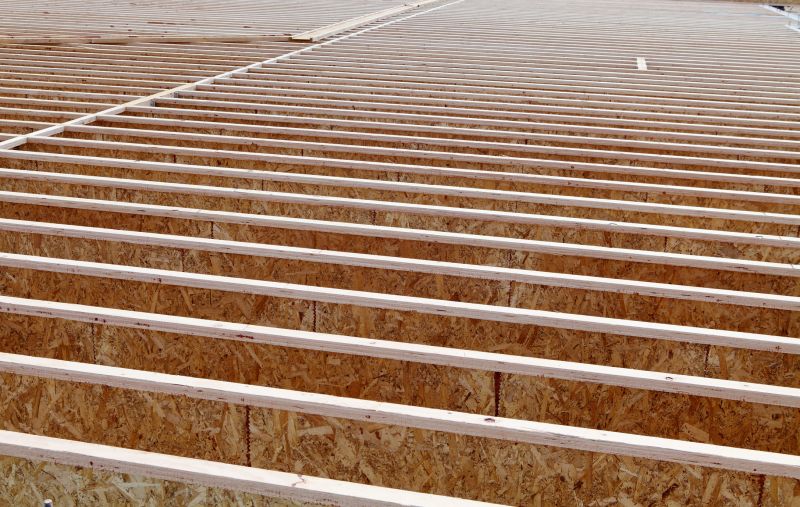Top-Rated Products For Floor Joist Reinforcement
Select from high-quality repair materials and tools designed to strengthen and support your floor framework effectively.
 Floor joist repairs are essential for maintaining the structural integrity and safety of a building's flooring system. When joists become damaged due to rot, pests, or structural stress, it can lead to sagging floors, creaking sounds, or even more serious issues if left unaddressed. Repairing or replacing damaged joists requires selecting appropriate products that provide stability, durability, and ease of installation. A variety of repair solutions are available to accommodate different types of damage and building configurations, ranging from simple reinforcement methods to complete replacement options.
Floor joist repairs are essential for maintaining the structural integrity and safety of a building's flooring system. When joists become damaged due to rot, pests, or structural stress, it can lead to sagging floors, creaking sounds, or even more serious issues if left unaddressed. Repairing or replacing damaged joists requires selecting appropriate products that provide stability, durability, and ease of installation. A variety of repair solutions are available to accommodate different types of damage and building configurations, ranging from simple reinforcement methods to complete replacement options.
Top Overall Option
Heavy-Duty Steel Floor Joist Support Brackets
Heavy-duty steel support brackets are designed to reinforce and stabilize damaged or weakened floor joists. They offer a robust, versatile solution that can be installed quickly with basic tools, providing immediate support and helping to distribute loads evenly. These brackets are suitable for a variety of joist sizes and can be used for both repair and reinforcement purposes, making them a reliable choice for structural stabilization.
Types of Products For Floor Joist Repairs
Sistering Lumber
Adding new lumber alongside existing joists to reinforce and support weakened areas.
Repair Brackets and Steel Supports
Metal brackets and supports designed to stabilize and reinforce damaged joists.
Joist Hangers
Metal hangers used to secure and support joists during repair or installation.
Concrete Pier Supports
Supports that elevate and stabilize joists over uneven or unstable ground.
Adjustable Post Supports
Posts that can be adjusted to level and support sagging floors.
Fiber-Reinforced Plywood
High-strength plywood used to replace or reinforce damaged subfloor sections.
Joist Repair Plates
Metal plates that reinforce cracked or split joists.
Epoxy and Wood Fillers
Resins and fillers for repairing cracks, splits, or rot in wood joists.
Leveling Shims
Shims used to level uneven joists or floors before final repairs.
Anchor Bolts and Fasteners
Heavy-duty fasteners for securing joists and supports firmly in place.
Post Bases and Mounts
Hardware used to secure adjustable supports to the foundation or framing.
Underpinning Posts
Posts used to transfer loads and support sagging or uneven floors.
Structural Wood Screws
Specialized screws designed for heavy-duty wood-to-wood connections.
Metal Straps and Ties
Straps used to reinforce cracked or split joists or framing members.
Plywood Blocking
Blocking material used to stabilize joist intersections or seams.
Popular Choices
A common method involving adding new lumber alongside existing joists for reinforcement.
Widely used for their strength and ease of installation to stabilize damaged joists.
Popular for securing joists during repairs and new installations.
Frequently chosen for leveling sagging floors effectively.
Trusted for filling cracks and restoring structural integrity of wood joists.
Commonly used to correct uneven joists and prepare for further reinforcement.
Popular for elevating and supporting joists over uneven or unstable ground.
Often used to reinforce cracked or split joists.
Essential for securing repair components firmly in place.
Used to reinforce weak or cracked joists and framing members.
Commonly selected for strengthening or replacing damaged subfloor sections.
Popular hardware for attaching adjustable supports securely.
Preferred for their strong hold in wood-to-wood connections.
Effective repair often begins with assessing the extent of the damage and choosing the right materials to reinforce or replace compromised joists. For minor issues, sistering with additional lumber can provide support, while for more severe damage, specialized repair brackets or steel supports may be necessary. Proper installation ensures that the repairs restore the load-bearing capacity of the floor system and prolong the lifespan of the structure. It's important to select products that are compatible with existing framing, easy to work with, and compliant with local building codes.
In addition to structural components, there are numerous accessories and supplementary products designed to facilitate repairs, such as fasteners, anchors, and leveling shims. These products help ensure a secure fit and proper alignment during repair work. When choosing repair products, consider factors such as load capacity, material compatibility, ease of installation, and the specific requirements of your project. Using high-quality, appropriate repair solutions can prevent future issues and maintain the safety and functionality of your flooring system over time.
Key Buying Considerations
- Assess the extent of damage to determine the appropriate repair method and product type.
- Ensure compatibility of repair products with existing joist materials and sizes.
- Consider load-bearing requirements and select products rated for your specific needs.
- Evaluate ease of installation and whether specialized tools are required.
- Check for compliance with local building codes and regulations.
- Choose durable materials that resist further deterioration over time.
- Look for adjustable or customizable options to accommodate different repair scenarios.
- Prioritize products that provide secure fastening and stable support.
- Consider the weight and size of repair components for ease of handling and installation.
- Review product warranties and manufacturer support for long-term reliability.
- Determine if additional accessories like fasteners or shims are needed for a complete repair.
- Factor in the environmental conditions of the space, such as moisture levels, which can affect material choice.
- Estimate the scope of the project to determine the quantity of materials required.
- Seek products with clear installation instructions or technical support if needed.
- Balance cost with quality to ensure effective and lasting repairs.
This content contains affiliate links. We may earn a commission if you make a purchase through these links, at no additional cost to you.
